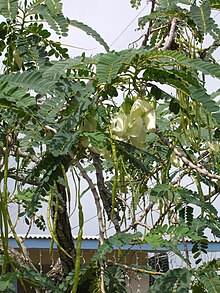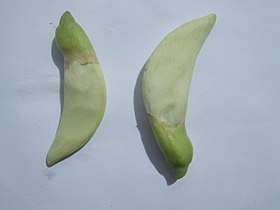| This article needs additional citations for verification. Please help improve this article by adding citations to reliable sources. Unsourced material may be challenged and removed. Find sources: "Sesbania grandiflora" – news · newspapers · books · scholar · JSTOR (November 2024) (Learn how and when to remove this message) |
| Sesbania grandiflora | |
|---|---|

| |
| Scientific classification | |
| Kingdom: | Plantae |
| Clade: | Tracheophytes |
| Clade: | Angiosperms |
| Clade: | Eudicots |
| Clade: | Rosids |
| Order: | Fabales |
| Family: | Fabaceae |
| Subfamily: | Faboideae |
| Clade: | Robinioids |
| Tribe: | Sesbanieae |
| Genus: | Sesbania |
| Species: | S. grandiflora |
| Binomial name | |
| Sesbania grandiflora (L.) Poir. | |
| Synonyms | |
| |
Sesbania grandiflora, common names vegetable hummingbird, katurai, agati, and West Indian pea, is a leguminous tree of family Fabaceae native to Maritime Southeast Asia and Northern Australia. The flowers are eaten in Southeast and South Asia.
Description
Sesbania grandiflora is a leguminous tree of family Fabaceae. It is fast-growing and soft-wooded, and it grows to heights of 5–20 metres (16–66 feet). The leaves are regular and rounded, and grow to 15–30 cm (6–12 in) long, with leaflets in 10–20 pairs or more and an odd one. The flowers white, red or pink and are oblong, 1.5–10 cm (1–4 in) long in lax, with two to four flower racemes. The calyx is campanulate and shallowly two-lipped. The fruits, or seed pods, look like flat, long, thin green beans. They are slender, falcate or straight, and 30–45 cm (12–18 in) long, with a thick suture, and each contains approximately thirty 8 mm (0.3 in) seeds. The tree thrives under full exposure to sunshine and is extremely frost sensitive.
-
 Botanical illustration
Botanical illustration
-
 Close-up of leaves
Close-up of leaves
-
 Detached flowers
Detached flowers
-
 Red-flowered variant
Red-flowered variant
-
 Pink-flowered variety
Pink-flowered variety
Distribution and habitat
It is native to Maritime Southeast Asia (Malaysia, Indonesia, Philippines, Brunei) to Northern Australia, and is cultivated in many parts of South India and Sri Lanka. It grows where there is good soil and a hot, humid climate.
Toxicity
Feed from the seed can be deadly to chickens.
Uses

S. grandiflora has many traditional uses. Its flowers are 92% water, 7% carbohydrates, 1% protein, and contain no fat. In a reference amount of 100 grams (3.5 oz), the flowers supply 27 calories, and are a rich source of vitamin C (88% of the U.S. and Canada Daily Value (DV)) and folate (26% DV).
Culinary
The flowers of S. grandiflora are eaten as a vegetable in Southeast Asia, including Java and Lombok in Indonesia, the Ilocos Region of the Philippines, Vietnam, Laos, and Thailand. In the Thai language, the flowers are called ดอกแค (dok khae) and are used in the cuisine both cooked in curries, such as kaeng som and kaeng khae, and raw or blanched with nam phrik. The flowers are also prominently used in Cambodian cuisine and are associated with the Bon Om Touk. The flower's stamen is generally discarded before use. In addition to raw and blanched, the flowers can also be battered and deep fried.
The leaves are also edible. The leaves are eaten young. The seed pods are also consumed, similarly only when young.
The leaves are sometimes available commercially, but flowers and seed pods come primarily from kitchen gardens.
Fodder
It is used to make highly nutritional fodder for ruminants like cattle, but it is deadly to chickens.
See also
- Sesbania bispinosa
- Dolichandrone spathacea, known as Dok khae thale in Thai
- Markhamia stipulata, known as Dok khae hua mu in Thai
- Edible flowers
- List of Thai ingredients
References
- ^ "Sesbania grandiflora (L.) Poir". Plants of the World Online. Royal Botanic Gardens, Kew. 2024. Retrieved 14 November 2024.
- NRCS. "Sesbania grandiflora". PLANTS Database. United States Department of Agriculture (USDA). Retrieved 10 November 2015.
- ^ Heering, J.H. & R.C. Gutteridge. 1992. Sesbania grandiflora (L.) Poir. Record from Proseabase. L.'t Mannetje and R.M. Jones. (Editors). Forages.: Plant Resources of South-East Asia 4: 196-198. PROSEA (Plant Resources of South-East Asia) Foundation, Bogor, Indonesia. Accessed from Internet: Feb 5, 2013
- Kirtikar K. R. & B. D. Basu, Indian Medicinal Plants Vol-I, International Book Distributor & Publisher, Dehradun, Edition 2005, bks pp. 735–736
- ^ "Sesbania flower, raw (per 100 g)". FoodData Central, US Department of Agriculture. 1 April 2019. Archived from the original on 3 April 2019. Retrieved 14 May 2023.
- ^ Hutton, Wendy (2004). A Cook's Guide to Asian Vegetables. Singapore: Periplus Editions. pp. 22–23. ISBN 0794600786.
- Thailand Illustrated Magazine Archived 2011-07-18 at the Wayback Machine
- Cucio, Ardy L.; Aragones, Julie Ann A. Katuray Production Guide (PDF). Bureau of Plant Industry, Department of Agriculture, Republic of the Philippines. Archived from the original (PDF) on 1 November 2019. Retrieved 9 February 2021.
External links
![]() Media related to Sesbania grandiflora at Wikimedia Commons
Media related to Sesbania grandiflora at Wikimedia Commons
| Taxon identifiers | |
|---|---|
| Sesbania grandiflora |
|
| Robinia grandiflora | |